HI6008 Business Research: Individual Reflective Journal - Reflection
VerifiedAdded on 2023/06/04
|9
|1919
|384
Journal and Reflective Writing
AI Summary
This individual reflective journal provides a comprehensive overview of a business research course, HI6008, spanning twelve weeks. The journal meticulously documents the student's learning journey through various research methodologies, including qualitative and quantitative approaches. Each week's entry reflects on specific topics such as research design, literature review, ethics, qualitative data analysis, sampling, structured interviewing, content analysis, and mixed methods research. The journal highlights key concepts, methodologies, and the student's critical engagement with the material. It covers topics such as the nature of business research, research design and planning, literature review, ethical considerations, qualitative research methods, quantitative research methods, and mixed methods research. The journal emphasizes practical application, critical thinking, and the development of research skills, providing a detailed account of the student's understanding and reflections throughout the course.
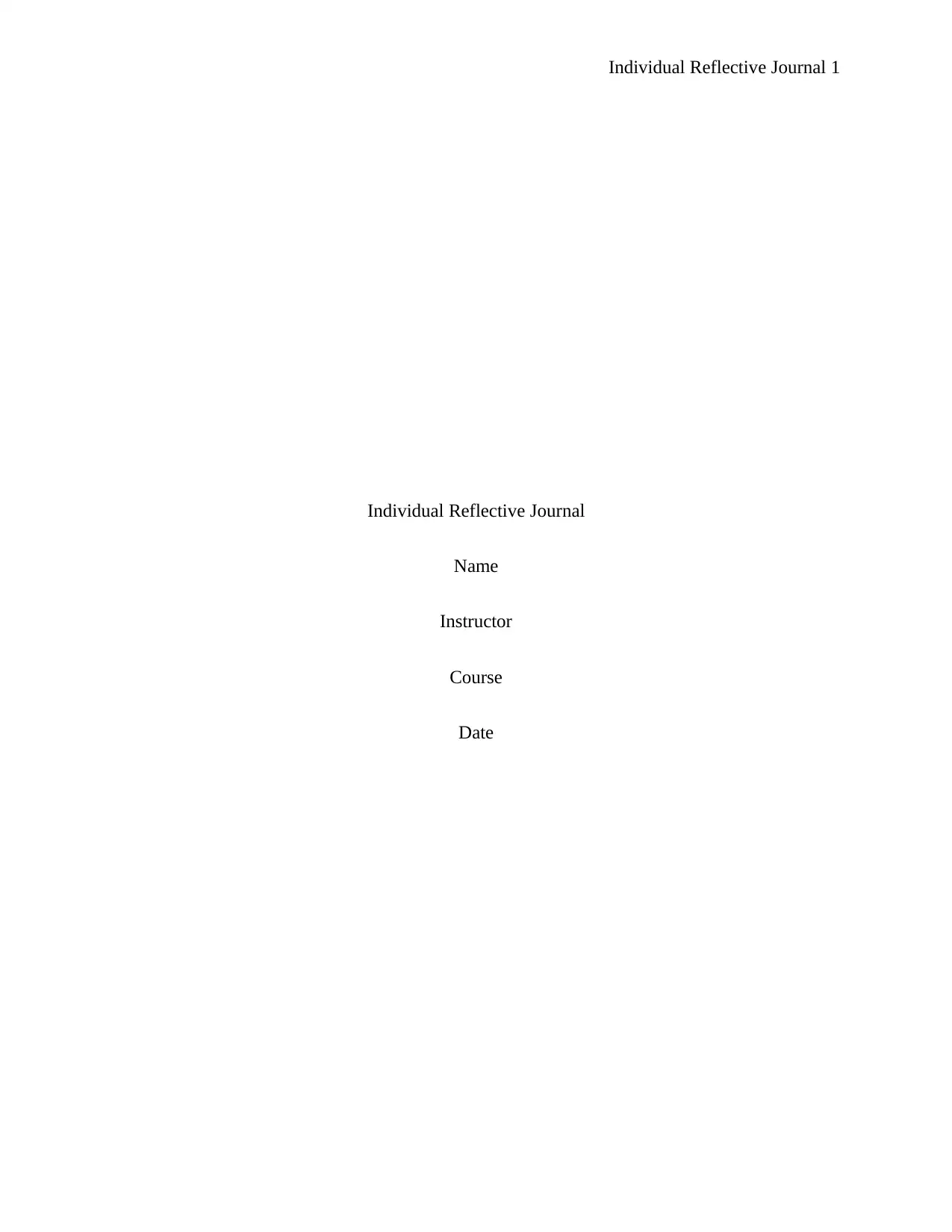
Individual Reflective Journal 1
Individual Reflective Journal
Name
Instructor
Course
Date
Individual Reflective Journal
Name
Instructor
Course
Date
Paraphrase This Document
Need a fresh take? Get an instant paraphrase of this document with our AI Paraphraser
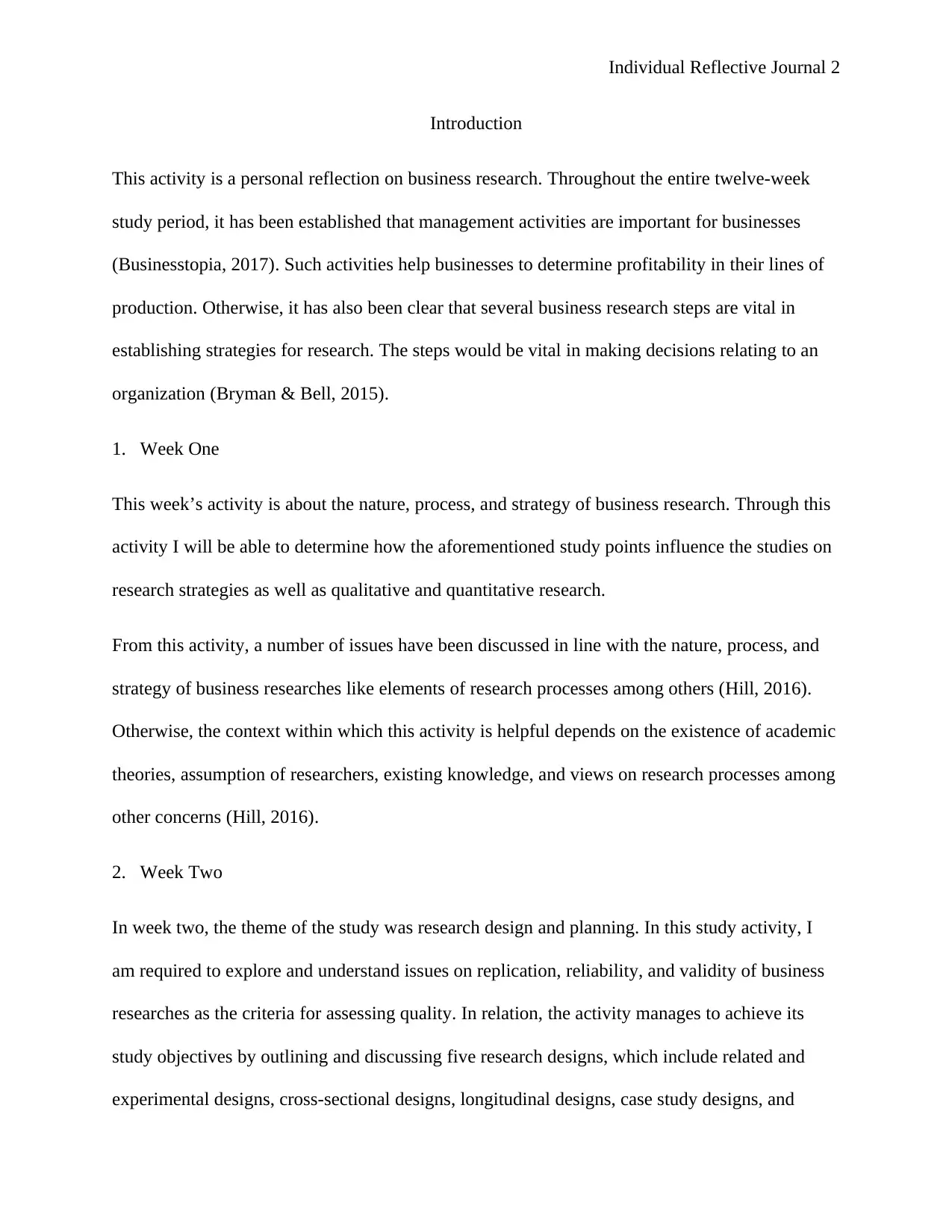
Individual Reflective Journal 2
Introduction
This activity is a personal reflection on business research. Throughout the entire twelve-week
study period, it has been established that management activities are important for businesses
(Businesstopia, 2017). Such activities help businesses to determine profitability in their lines of
production. Otherwise, it has also been clear that several business research steps are vital in
establishing strategies for research. The steps would be vital in making decisions relating to an
organization (Bryman & Bell, 2015).
1. Week One
This week’s activity is about the nature, process, and strategy of business research. Through this
activity I will be able to determine how the aforementioned study points influence the studies on
research strategies as well as qualitative and quantitative research.
From this activity, a number of issues have been discussed in line with the nature, process, and
strategy of business researches like elements of research processes among others (Hill, 2016).
Otherwise, the context within which this activity is helpful depends on the existence of academic
theories, assumption of researchers, existing knowledge, and views on research processes among
other concerns (Hill, 2016).
2. Week Two
In week two, the theme of the study was research design and planning. In this study activity, I
am required to explore and understand issues on replication, reliability, and validity of business
researches as the criteria for assessing quality. In relation, the activity manages to achieve its
study objectives by outlining and discussing five research designs, which include related and
experimental designs, cross-sectional designs, longitudinal designs, case study designs, and
Introduction
This activity is a personal reflection on business research. Throughout the entire twelve-week
study period, it has been established that management activities are important for businesses
(Businesstopia, 2017). Such activities help businesses to determine profitability in their lines of
production. Otherwise, it has also been clear that several business research steps are vital in
establishing strategies for research. The steps would be vital in making decisions relating to an
organization (Bryman & Bell, 2015).
1. Week One
This week’s activity is about the nature, process, and strategy of business research. Through this
activity I will be able to determine how the aforementioned study points influence the studies on
research strategies as well as qualitative and quantitative research.
From this activity, a number of issues have been discussed in line with the nature, process, and
strategy of business researches like elements of research processes among others (Hill, 2016).
Otherwise, the context within which this activity is helpful depends on the existence of academic
theories, assumption of researchers, existing knowledge, and views on research processes among
other concerns (Hill, 2016).
2. Week Two
In week two, the theme of the study was research design and planning. In this study activity, I
am required to explore and understand issues on replication, reliability, and validity of business
researches as the criteria for assessing quality. In relation, the activity manages to achieve its
study objectives by outlining and discussing five research designs, which include related and
experimental designs, cross-sectional designs, longitudinal designs, case study designs, and
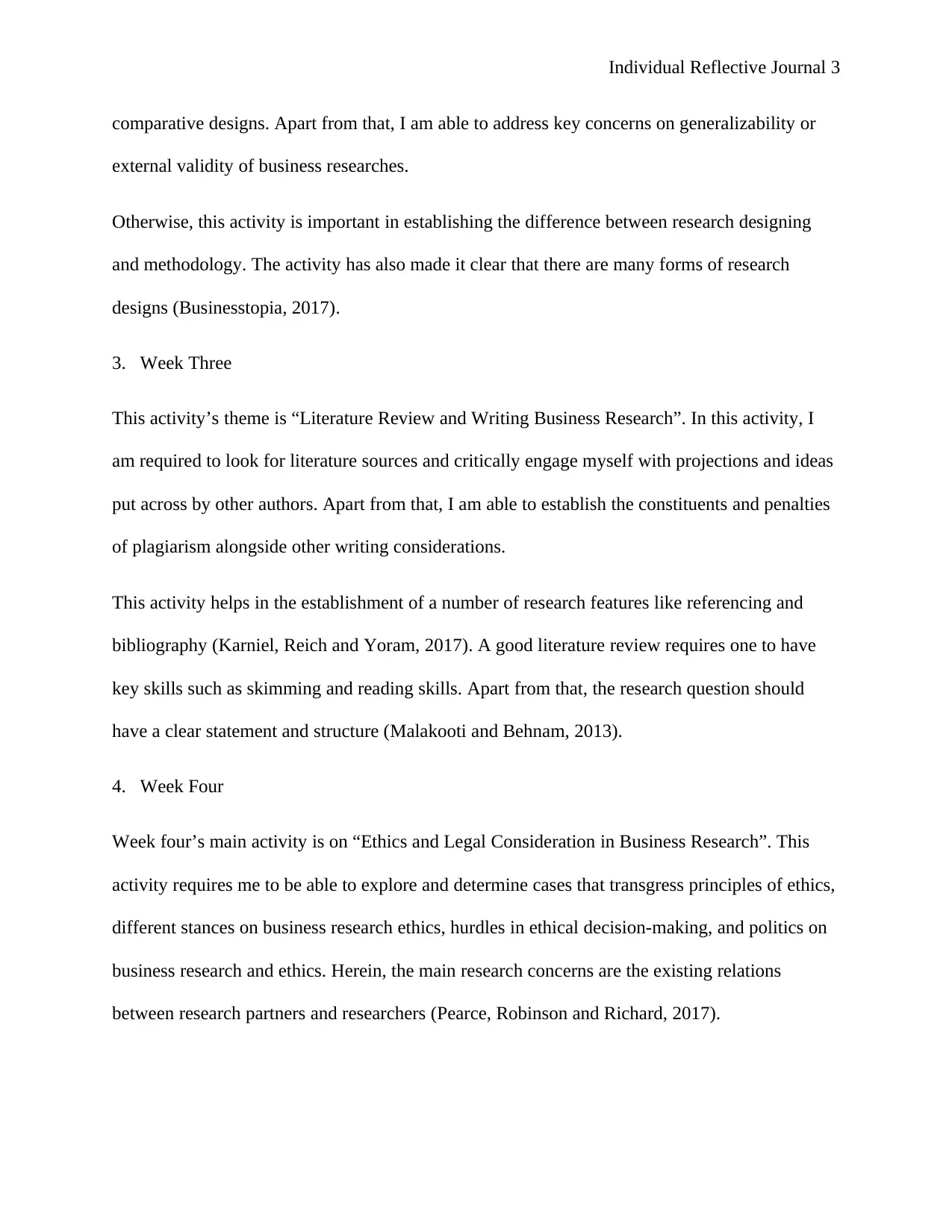
Individual Reflective Journal 3
comparative designs. Apart from that, I am able to address key concerns on generalizability or
external validity of business researches.
Otherwise, this activity is important in establishing the difference between research designing
and methodology. The activity has also made it clear that there are many forms of research
designs (Businesstopia, 2017).
3. Week Three
This activity’s theme is “Literature Review and Writing Business Research”. In this activity, I
am required to look for literature sources and critically engage myself with projections and ideas
put across by other authors. Apart from that, I am able to establish the constituents and penalties
of plagiarism alongside other writing considerations.
This activity helps in the establishment of a number of research features like referencing and
bibliography (Karniel, Reich and Yoram, 2017). A good literature review requires one to have
key skills such as skimming and reading skills. Apart from that, the research question should
have a clear statement and structure (Malakooti and Behnam, 2013).
4. Week Four
Week four’s main activity is on “Ethics and Legal Consideration in Business Research”. This
activity requires me to be able to explore and determine cases that transgress principles of ethics,
different stances on business research ethics, hurdles in ethical decision-making, and politics on
business research and ethics. Herein, the main research concerns are the existing relations
between research partners and researchers (Pearce, Robinson and Richard, 2017).
comparative designs. Apart from that, I am able to address key concerns on generalizability or
external validity of business researches.
Otherwise, this activity is important in establishing the difference between research designing
and methodology. The activity has also made it clear that there are many forms of research
designs (Businesstopia, 2017).
3. Week Three
This activity’s theme is “Literature Review and Writing Business Research”. In this activity, I
am required to look for literature sources and critically engage myself with projections and ideas
put across by other authors. Apart from that, I am able to establish the constituents and penalties
of plagiarism alongside other writing considerations.
This activity helps in the establishment of a number of research features like referencing and
bibliography (Karniel, Reich and Yoram, 2017). A good literature review requires one to have
key skills such as skimming and reading skills. Apart from that, the research question should
have a clear statement and structure (Malakooti and Behnam, 2013).
4. Week Four
Week four’s main activity is on “Ethics and Legal Consideration in Business Research”. This
activity requires me to be able to explore and determine cases that transgress principles of ethics,
different stances on business research ethics, hurdles in ethical decision-making, and politics on
business research and ethics. Herein, the main research concerns are the existing relations
between research partners and researchers (Pearce, Robinson and Richard, 2017).
⊘ This is a preview!⊘
Do you want full access?
Subscribe today to unlock all pages.

Trusted by 1+ million students worldwide
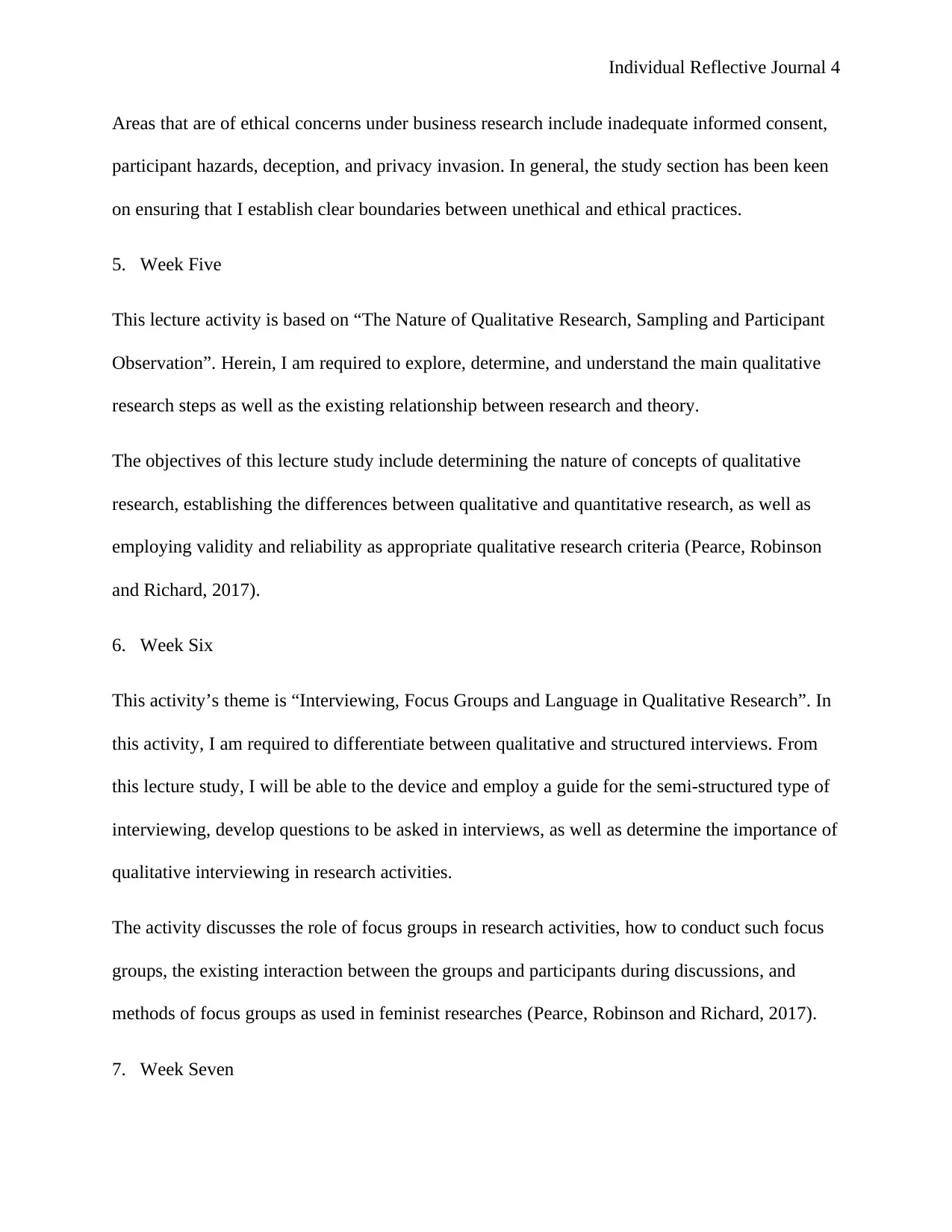
Individual Reflective Journal 4
Areas that are of ethical concerns under business research include inadequate informed consent,
participant hazards, deception, and privacy invasion. In general, the study section has been keen
on ensuring that I establish clear boundaries between unethical and ethical practices.
5. Week Five
This lecture activity is based on “The Nature of Qualitative Research, Sampling and Participant
Observation”. Herein, I am required to explore, determine, and understand the main qualitative
research steps as well as the existing relationship between research and theory.
The objectives of this lecture study include determining the nature of concepts of qualitative
research, establishing the differences between qualitative and quantitative research, as well as
employing validity and reliability as appropriate qualitative research criteria (Pearce, Robinson
and Richard, 2017).
6. Week Six
This activity’s theme is “Interviewing, Focus Groups and Language in Qualitative Research”. In
this activity, I am required to differentiate between qualitative and structured interviews. From
this lecture study, I will be able to the device and employ a guide for the semi-structured type of
interviewing, develop questions to be asked in interviews, as well as determine the importance of
qualitative interviewing in research activities.
The activity discusses the role of focus groups in research activities, how to conduct such focus
groups, the existing interaction between the groups and participants during discussions, and
methods of focus groups as used in feminist researches (Pearce, Robinson and Richard, 2017).
7. Week Seven
Areas that are of ethical concerns under business research include inadequate informed consent,
participant hazards, deception, and privacy invasion. In general, the study section has been keen
on ensuring that I establish clear boundaries between unethical and ethical practices.
5. Week Five
This lecture activity is based on “The Nature of Qualitative Research, Sampling and Participant
Observation”. Herein, I am required to explore, determine, and understand the main qualitative
research steps as well as the existing relationship between research and theory.
The objectives of this lecture study include determining the nature of concepts of qualitative
research, establishing the differences between qualitative and quantitative research, as well as
employing validity and reliability as appropriate qualitative research criteria (Pearce, Robinson
and Richard, 2017).
6. Week Six
This activity’s theme is “Interviewing, Focus Groups and Language in Qualitative Research”. In
this activity, I am required to differentiate between qualitative and structured interviews. From
this lecture study, I will be able to the device and employ a guide for the semi-structured type of
interviewing, develop questions to be asked in interviews, as well as determine the importance of
qualitative interviewing in research activities.
The activity discusses the role of focus groups in research activities, how to conduct such focus
groups, the existing interaction between the groups and participants during discussions, and
methods of focus groups as used in feminist researches (Pearce, Robinson and Richard, 2017).
7. Week Seven
Paraphrase This Document
Need a fresh take? Get an instant paraphrase of this document with our AI Paraphraser
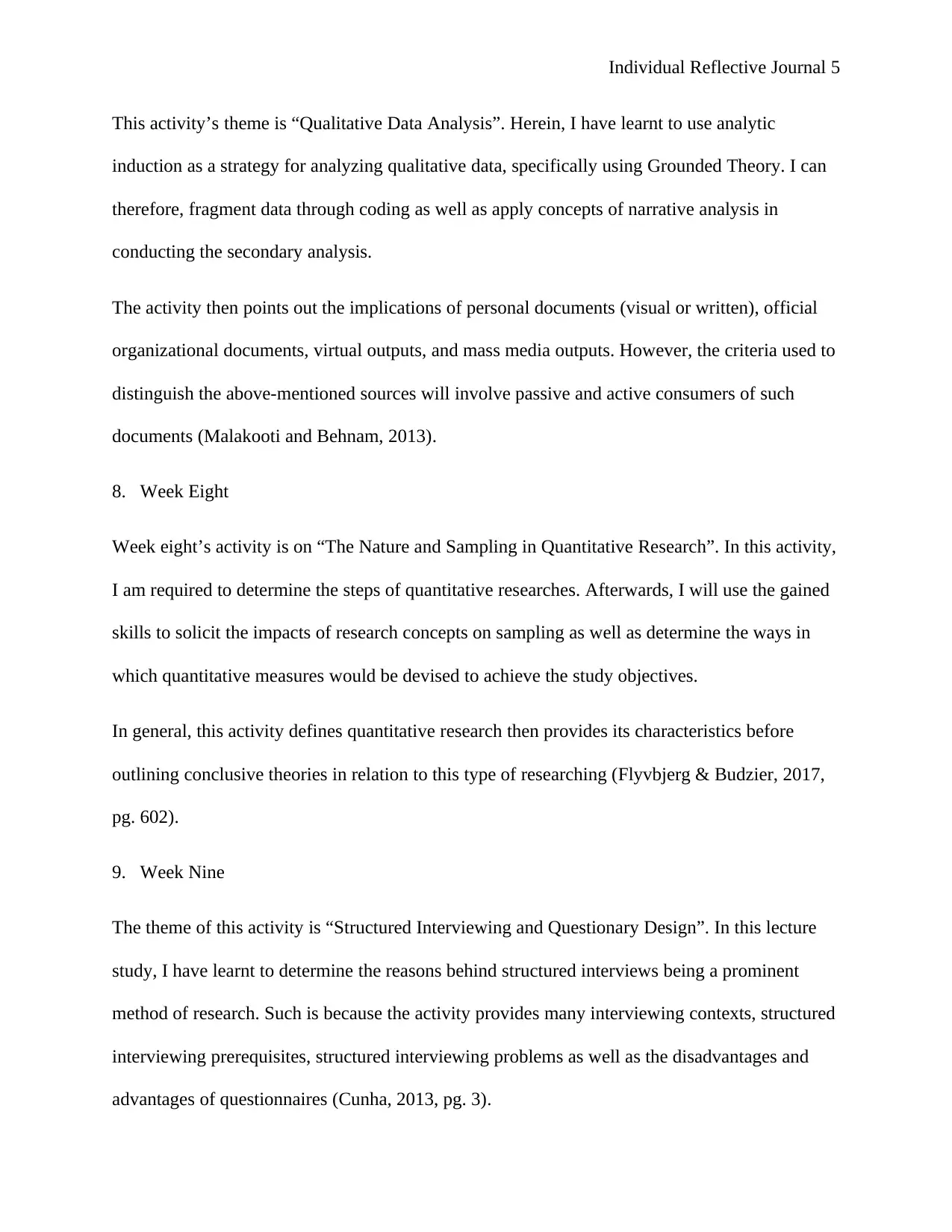
Individual Reflective Journal 5
This activity’s theme is “Qualitative Data Analysis”. Herein, I have learnt to use analytic
induction as a strategy for analyzing qualitative data, specifically using Grounded Theory. I can
therefore, fragment data through coding as well as apply concepts of narrative analysis in
conducting the secondary analysis.
The activity then points out the implications of personal documents (visual or written), official
organizational documents, virtual outputs, and mass media outputs. However, the criteria used to
distinguish the above-mentioned sources will involve passive and active consumers of such
documents (Malakooti and Behnam, 2013).
8. Week Eight
Week eight’s activity is on “The Nature and Sampling in Quantitative Research”. In this activity,
I am required to determine the steps of quantitative researches. Afterwards, I will use the gained
skills to solicit the impacts of research concepts on sampling as well as determine the ways in
which quantitative measures would be devised to achieve the study objectives.
In general, this activity defines quantitative research then provides its characteristics before
outlining conclusive theories in relation to this type of researching (Flyvbjerg & Budzier, 2017,
pg. 602).
9. Week Nine
The theme of this activity is “Structured Interviewing and Questionary Design”. In this lecture
study, I have learnt to determine the reasons behind structured interviews being a prominent
method of research. Such is because the activity provides many interviewing contexts, structured
interviewing prerequisites, structured interviewing problems as well as the disadvantages and
advantages of questionnaires (Cunha, 2013, pg. 3).
This activity’s theme is “Qualitative Data Analysis”. Herein, I have learnt to use analytic
induction as a strategy for analyzing qualitative data, specifically using Grounded Theory. I can
therefore, fragment data through coding as well as apply concepts of narrative analysis in
conducting the secondary analysis.
The activity then points out the implications of personal documents (visual or written), official
organizational documents, virtual outputs, and mass media outputs. However, the criteria used to
distinguish the above-mentioned sources will involve passive and active consumers of such
documents (Malakooti and Behnam, 2013).
8. Week Eight
Week eight’s activity is on “The Nature and Sampling in Quantitative Research”. In this activity,
I am required to determine the steps of quantitative researches. Afterwards, I will use the gained
skills to solicit the impacts of research concepts on sampling as well as determine the ways in
which quantitative measures would be devised to achieve the study objectives.
In general, this activity defines quantitative research then provides its characteristics before
outlining conclusive theories in relation to this type of researching (Flyvbjerg & Budzier, 2017,
pg. 602).
9. Week Nine
The theme of this activity is “Structured Interviewing and Questionary Design”. In this lecture
study, I have learnt to determine the reasons behind structured interviews being a prominent
method of research. Such is because the activity provides many interviewing contexts, structured
interviewing prerequisites, structured interviewing problems as well as the disadvantages and
advantages of questionnaires (Cunha, 2013, pg. 3).
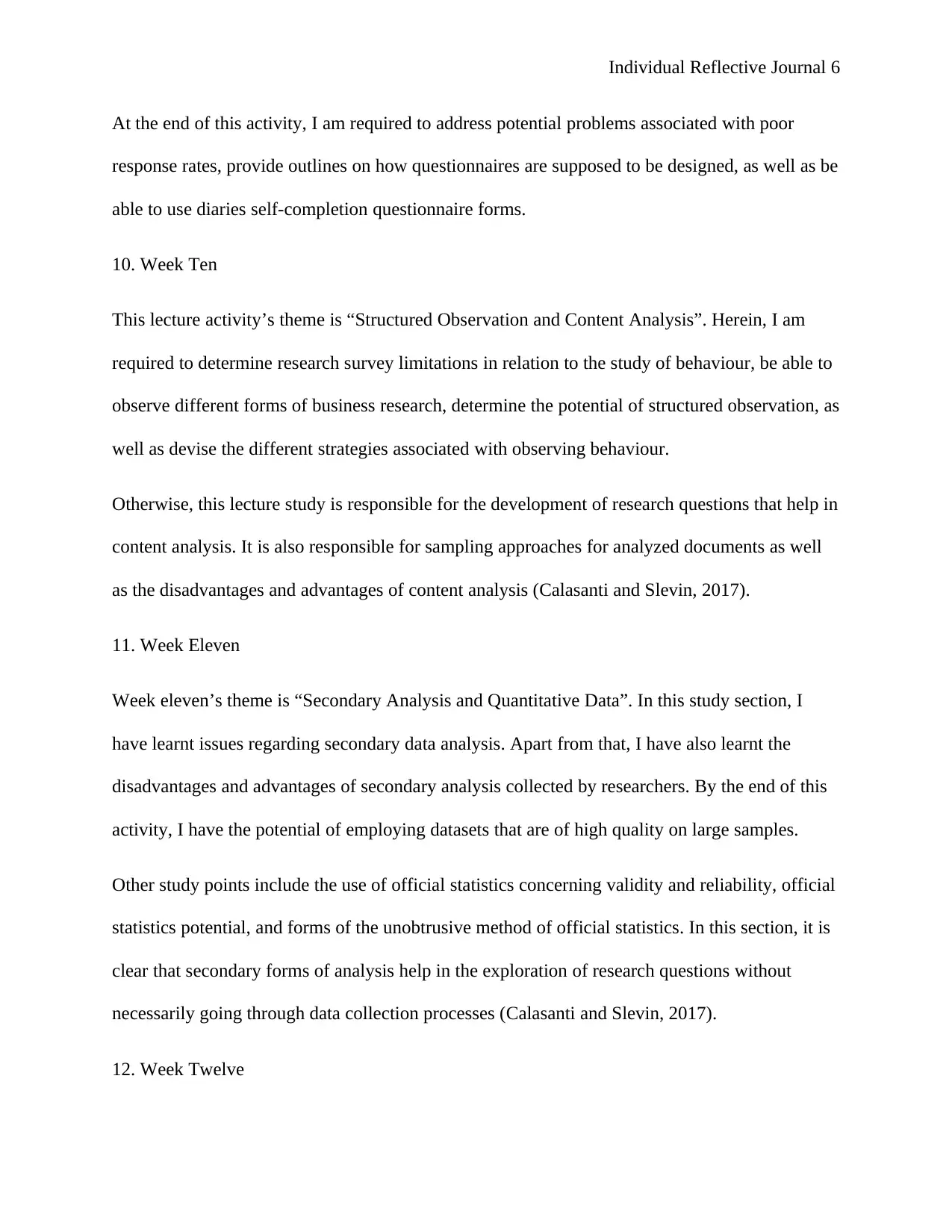
Individual Reflective Journal 6
At the end of this activity, I am required to address potential problems associated with poor
response rates, provide outlines on how questionnaires are supposed to be designed, as well as be
able to use diaries self-completion questionnaire forms.
10. Week Ten
This lecture activity’s theme is “Structured Observation and Content Analysis”. Herein, I am
required to determine research survey limitations in relation to the study of behaviour, be able to
observe different forms of business research, determine the potential of structured observation, as
well as devise the different strategies associated with observing behaviour.
Otherwise, this lecture study is responsible for the development of research questions that help in
content analysis. It is also responsible for sampling approaches for analyzed documents as well
as the disadvantages and advantages of content analysis (Calasanti and Slevin, 2017).
11. Week Eleven
Week eleven’s theme is “Secondary Analysis and Quantitative Data”. In this study section, I
have learnt issues regarding secondary data analysis. Apart from that, I have also learnt the
disadvantages and advantages of secondary analysis collected by researchers. By the end of this
activity, I have the potential of employing datasets that are of high quality on large samples.
Other study points include the use of official statistics concerning validity and reliability, official
statistics potential, and forms of the unobtrusive method of official statistics. In this section, it is
clear that secondary forms of analysis help in the exploration of research questions without
necessarily going through data collection processes (Calasanti and Slevin, 2017).
12. Week Twelve
At the end of this activity, I am required to address potential problems associated with poor
response rates, provide outlines on how questionnaires are supposed to be designed, as well as be
able to use diaries self-completion questionnaire forms.
10. Week Ten
This lecture activity’s theme is “Structured Observation and Content Analysis”. Herein, I am
required to determine research survey limitations in relation to the study of behaviour, be able to
observe different forms of business research, determine the potential of structured observation, as
well as devise the different strategies associated with observing behaviour.
Otherwise, this lecture study is responsible for the development of research questions that help in
content analysis. It is also responsible for sampling approaches for analyzed documents as well
as the disadvantages and advantages of content analysis (Calasanti and Slevin, 2017).
11. Week Eleven
Week eleven’s theme is “Secondary Analysis and Quantitative Data”. In this study section, I
have learnt issues regarding secondary data analysis. Apart from that, I have also learnt the
disadvantages and advantages of secondary analysis collected by researchers. By the end of this
activity, I have the potential of employing datasets that are of high quality on large samples.
Other study points include the use of official statistics concerning validity and reliability, official
statistics potential, and forms of the unobtrusive method of official statistics. In this section, it is
clear that secondary forms of analysis help in the exploration of research questions without
necessarily going through data collection processes (Calasanti and Slevin, 2017).
12. Week Twelve
⊘ This is a preview!⊘
Do you want full access?
Subscribe today to unlock all pages.

Trusted by 1+ million students worldwide
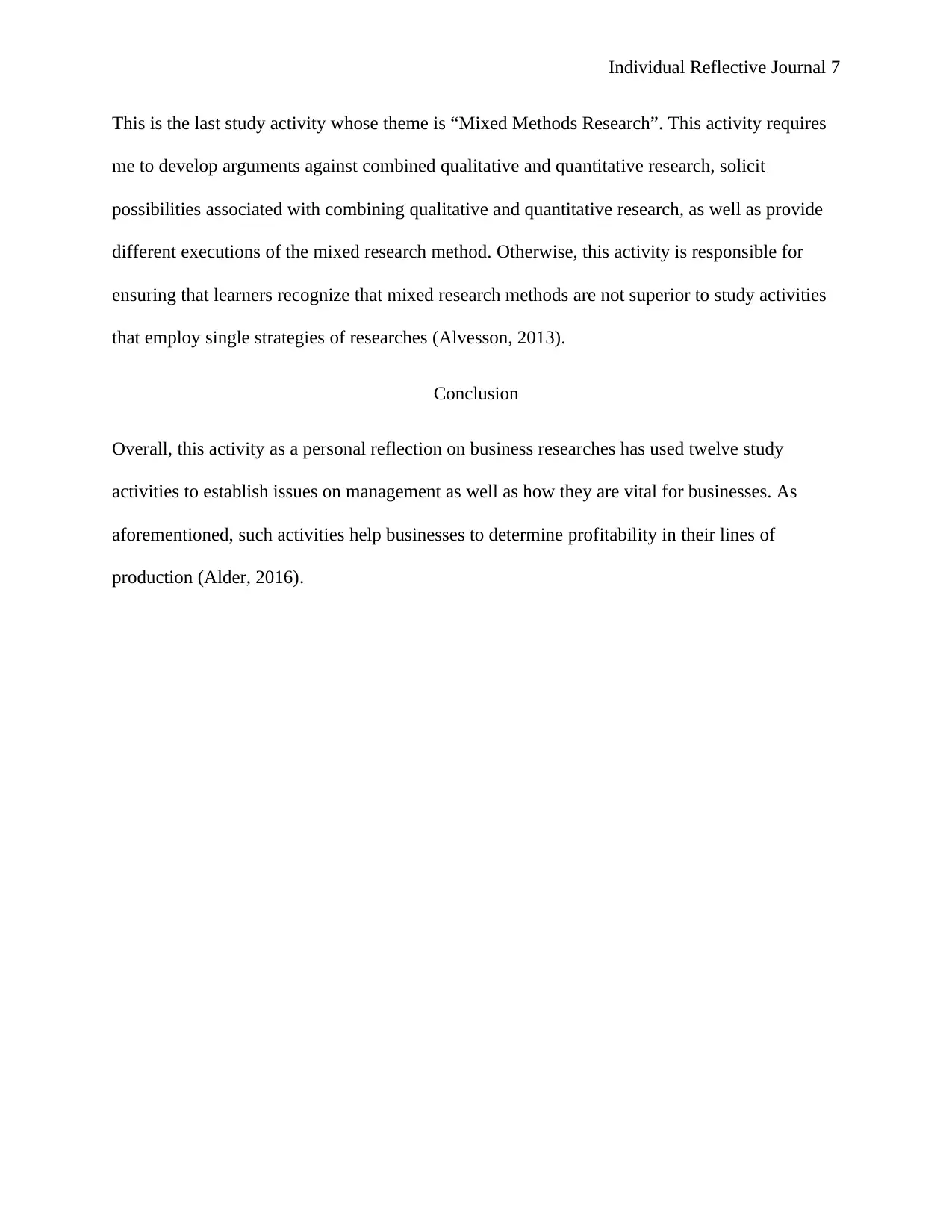
Individual Reflective Journal 7
This is the last study activity whose theme is “Mixed Methods Research”. This activity requires
me to develop arguments against combined qualitative and quantitative research, solicit
possibilities associated with combining qualitative and quantitative research, as well as provide
different executions of the mixed research method. Otherwise, this activity is responsible for
ensuring that learners recognize that mixed research methods are not superior to study activities
that employ single strategies of researches (Alvesson, 2013).
Conclusion
Overall, this activity as a personal reflection on business researches has used twelve study
activities to establish issues on management as well as how they are vital for businesses. As
aforementioned, such activities help businesses to determine profitability in their lines of
production (Alder, 2016).
This is the last study activity whose theme is “Mixed Methods Research”. This activity requires
me to develop arguments against combined qualitative and quantitative research, solicit
possibilities associated with combining qualitative and quantitative research, as well as provide
different executions of the mixed research method. Otherwise, this activity is responsible for
ensuring that learners recognize that mixed research methods are not superior to study activities
that employ single strategies of researches (Alvesson, 2013).
Conclusion
Overall, this activity as a personal reflection on business researches has used twelve study
activities to establish issues on management as well as how they are vital for businesses. As
aforementioned, such activities help businesses to determine profitability in their lines of
production (Alder, 2016).
Paraphrase This Document
Need a fresh take? Get an instant paraphrase of this document with our AI Paraphraser
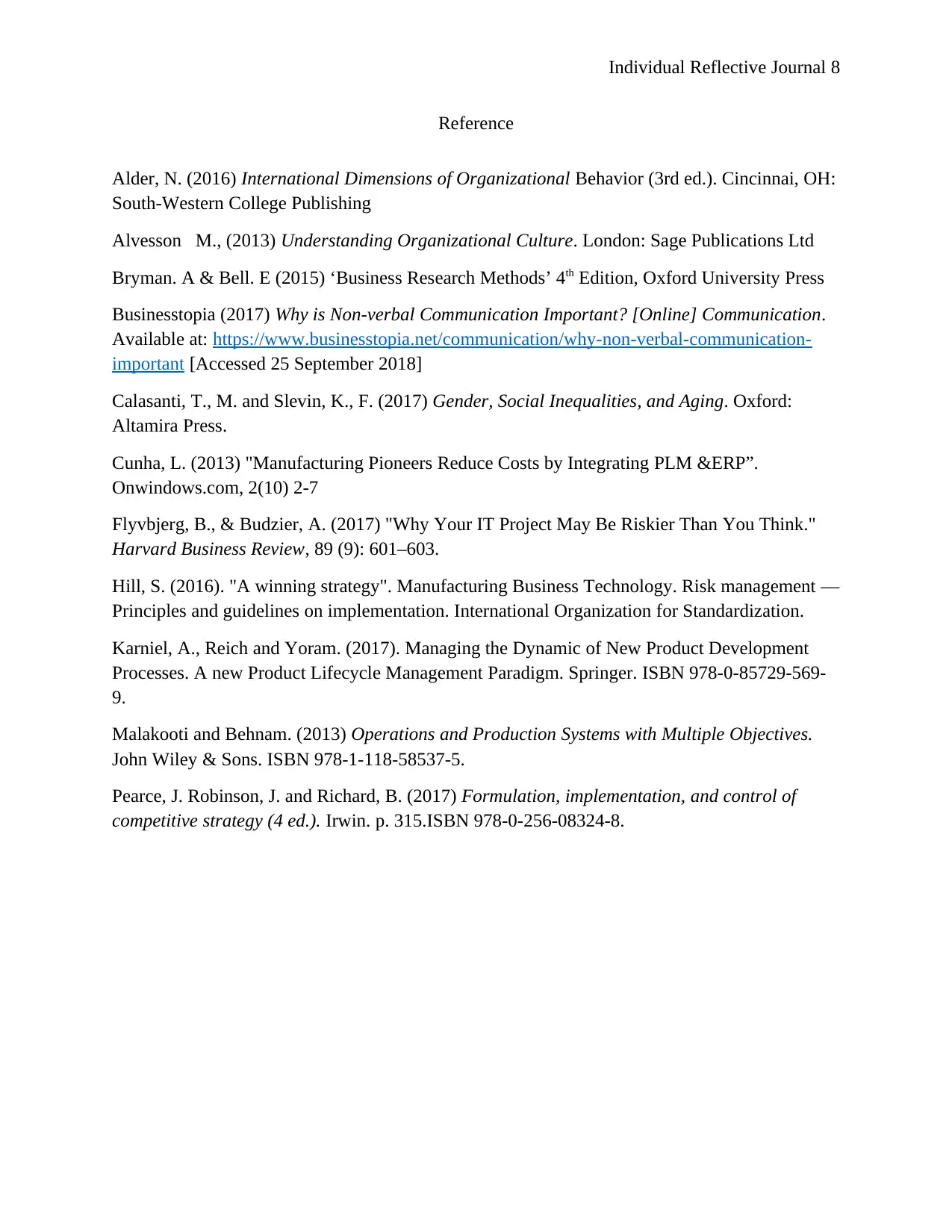
Individual Reflective Journal 8
Reference
Alder, N. (2016) International Dimensions of Organizational Behavior (3rd ed.). Cincinnai, OH:
South-Western College Publishing
Alvesson M., (2013) Understanding Organizational Culture. London: Sage Publications Ltd
Bryman. A & Bell. E (2015) ‘Business Research Methods’ 4th Edition, Oxford University Press
Businesstopia (2017) Why is Non-verbal Communication Important? [Online] Communication.
Available at: https://www.businesstopia.net/communication/why-non-verbal-communication-
important [Accessed 25 September 2018]
Calasanti, T., M. and Slevin, K., F. (2017) Gender, Social Inequalities, and Aging. Oxford:
Altamira Press.
Cunha, L. (2013) "Manufacturing Pioneers Reduce Costs by Integrating PLM &ERP”.
Onwindows.com, 2(10) 2-7
Flyvbjerg, B., & Budzier, A. (2017) "Why Your IT Project May Be Riskier Than You Think."
Harvard Business Review, 89 (9): 601–603.
Hill, S. (2016). "A winning strategy". Manufacturing Business Technology. Risk management —
Principles and guidelines on implementation. International Organization for Standardization.
Karniel, A., Reich and Yoram. (2017). Managing the Dynamic of New Product Development
Processes. A new Product Lifecycle Management Paradigm. Springer. ISBN 978-0-85729-569-
9.
Malakooti and Behnam. (2013) Operations and Production Systems with Multiple Objectives.
John Wiley & Sons. ISBN 978-1-118-58537-5.
Pearce, J. Robinson, J. and Richard, B. (2017) Formulation, implementation, and control of
competitive strategy (4 ed.). Irwin. p. 315.ISBN 978-0-256-08324-8.
Reference
Alder, N. (2016) International Dimensions of Organizational Behavior (3rd ed.). Cincinnai, OH:
South-Western College Publishing
Alvesson M., (2013) Understanding Organizational Culture. London: Sage Publications Ltd
Bryman. A & Bell. E (2015) ‘Business Research Methods’ 4th Edition, Oxford University Press
Businesstopia (2017) Why is Non-verbal Communication Important? [Online] Communication.
Available at: https://www.businesstopia.net/communication/why-non-verbal-communication-
important [Accessed 25 September 2018]
Calasanti, T., M. and Slevin, K., F. (2017) Gender, Social Inequalities, and Aging. Oxford:
Altamira Press.
Cunha, L. (2013) "Manufacturing Pioneers Reduce Costs by Integrating PLM &ERP”.
Onwindows.com, 2(10) 2-7
Flyvbjerg, B., & Budzier, A. (2017) "Why Your IT Project May Be Riskier Than You Think."
Harvard Business Review, 89 (9): 601–603.
Hill, S. (2016). "A winning strategy". Manufacturing Business Technology. Risk management —
Principles and guidelines on implementation. International Organization for Standardization.
Karniel, A., Reich and Yoram. (2017). Managing the Dynamic of New Product Development
Processes. A new Product Lifecycle Management Paradigm. Springer. ISBN 978-0-85729-569-
9.
Malakooti and Behnam. (2013) Operations and Production Systems with Multiple Objectives.
John Wiley & Sons. ISBN 978-1-118-58537-5.
Pearce, J. Robinson, J. and Richard, B. (2017) Formulation, implementation, and control of
competitive strategy (4 ed.). Irwin. p. 315.ISBN 978-0-256-08324-8.

Individual Reflective Journal 9
⊘ This is a preview!⊘
Do you want full access?
Subscribe today to unlock all pages.

Trusted by 1+ million students worldwide
1 out of 9
Related Documents
Your All-in-One AI-Powered Toolkit for Academic Success.
+13062052269
info@desklib.com
Available 24*7 on WhatsApp / Email
![[object Object]](/_next/static/media/star-bottom.7253800d.svg)
Unlock your academic potential
Copyright © 2020–2025 A2Z Services. All Rights Reserved. Developed and managed by ZUCOL.




